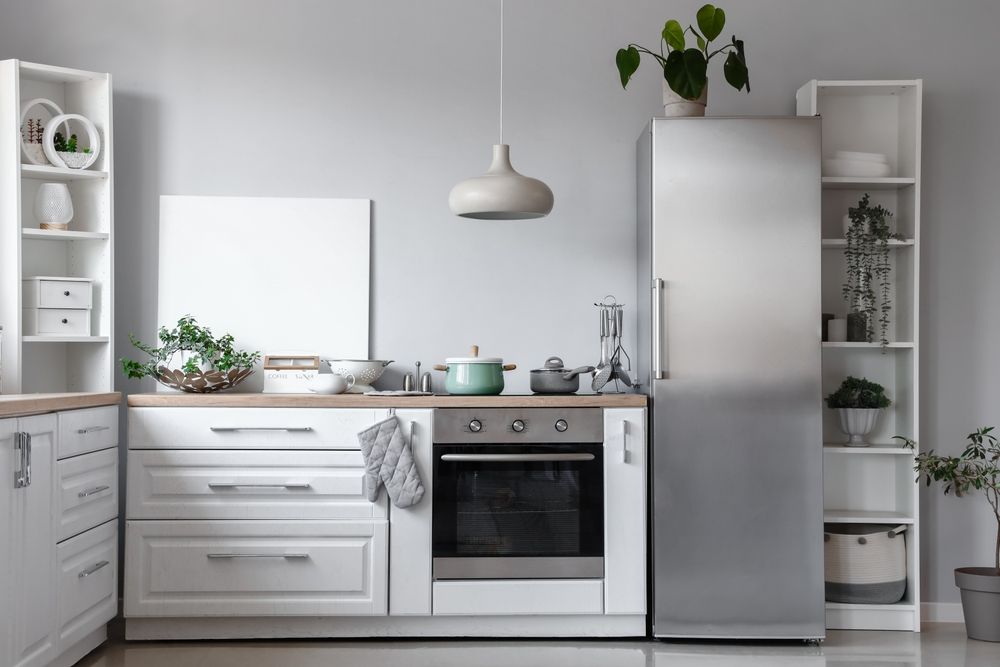A refrigerator is more than just a kitchen appliance—it’s a long-term investment that can impact your energy bills, your cooking habits, and even your home’s aesthetic. With an array of features, sizes, and styles on the market, it can be daunting to choose the right one.
1. Measure Your Space—Then Measure Again
Refrigerators can vary greatly in size. Nothing’s worse than finding the perfect fridge only to discover it won’t fit through your doorway or into its designated kitchen nook.
How to Do It
- Height, Width, and Depth: Measure the exact dimensions of the space where the fridge will go. Don’t forget to account for extra room if you plan on having the doors swing open near cabinets or walls.
- Doorway Clearance: Check if the fridge can navigate the path from your entryway to the kitchen. Hallways, sharp turns, or narrow doors can all be obstacles.
- Ventilation: Most refrigerator models need a bit of breathing space at the back and on the sides for proper airflow and to prevent overheating.
2. Choose the Right Style
Fridges come in multiple configurations—each with its own advantages and drawbacks. Consider how you use your fridge, your kitchen layout, and the look you’re going for.
Common Styles
- Top-Freezer: A classic design with the freezer on top, offering reliability and affordability. These models are typically more budget-friendly.
- Bottom-Freezer: The freezer drawer is located at the bottom, keeping refrigerated items at eye level—convenient if you mostly consume fresh foods.
- Side-by-Side: The fridge and freezer sections run vertically, making it easier to organize. However, interior width can be limited for large items like pizza boxes.
- French Door: A modern style combining side-by-side doors on top with a freezer drawer below. These often come with extra features and are popular for spacious interiors.
- Counter-Depth: These models are shallower so that they align with counters and cabinets, giving the kitchen a more streamlined look.
3. Prioritize Capacity and Organization
A fridge isn’t just about external dimensions; internal storage matters. Shelves, compartments, and drawers can greatly impact how effectively you use the space.
What to Look For
- Adjustable Shelves: Shelves that can be rearranged or folded back to accommodate tall items like juice bottles or large containers.
- Dedicated Compartments: Drawers for meats, cheeses, fruits, and vegetables help maintain freshness by creating different humidity zones.
- Door Bins: Deep bins can store condiment bottles, milk jugs, or beverages, freeing up shelf space.
4. Check Energy Efficiency
Since a fridge runs around the clock, it can account for a significant portion of your monthly utility bill. Investing in an energy-efficient model can lead to substantial long-term savings.
How to Identify Efficiency
- Energy Star Label: In many regions, this label indicates the appliance meets or exceeds energy-efficiency standards.
- Annual Energy Consumption: Check the fridge’s energy guide; it shows an estimate of yearly electricity usage, helping you compare models effectively.
- Smart Inverter Compressors: Some fridges come with inverter technology that adjusts cooling based on usage, lowering energy consumption.
5. Consider Special Features
Modern refrigerators come packed with extra features ranging from convenient to high-tech. While not all are essential, they can enhance your daily life—if they align with your habits.
Popular Features
- Water and Ice Dispenser: Convenient for chilled water or ice on demand, but can increase cost and might require extra maintenance.
- Smart Connectivity: Allows you to control temperature settings, receive alerts, or shop for groceries through an app.
- Door-in-Door Storage: Access commonly used items without opening the entire fridge, conserving energy.
- Temperature-Controlled Drawers: Let you adjust a drawer’s temperature independently for different types of food.

6. Noise Levels Matter
A noisy fridge can be a constant annoyance, especially in open-concept homes where the kitchen, dining, and living areas blend.
What to Do
- Research Decibel Ratings: Some manufacturers list noise levels. A rating of around 40 dB or lower is considered quiet.
- Read Reviews: Online customer feedback can offer real-world insights on whether a model hums too loudly.
- Location: If your fridge is near a bedroom or a living space where silence is golden, paying attention to noise levels is critical.
7. Maintenance and Cleaning
A refrigerator is a long-term companion in your kitchen. Models that are difficult to clean or prone to certain issues can be a headache in the long run.
What to Look For
- Removable Shelves and Bins: Make sure shelves and bins are easy to remove and wipe down.
- Fingerprint-Resistant Finishes: Stainless steel looks sleek but can show smudges. Fingerprint-resistant coatings cut down on constant polishing.
- Filter Replacements: If you have a built-in water dispenser or ice maker, consider the cost and frequency of filter replacements.
8. Verify Warranty and Customer Support
Refrigerators are complex appliances that can fail due to electronics, compressors, or cooling components. A good warranty and reliable customer support can be a lifesaver if something goes wrong.
What to Check
- Warranty Length: Manufacturers often provide different coverage lengths for parts and labor, sometimes including extended compressor warranties.
- Service Network: Look for brands with a robust local service network or authorized repair centers in your area.
- Customer Reviews: Real-world feedback on how brands handle warranty claims can be illuminating.
9. Think About Long-Term Reliability
A fridge should last you well over a decade. Prioritizing brands and models known for reliability can save you from costly repairs—or an early replacement.
How to Gauge Reliability
- Brand Reputation: Some manufacturers have a track record for durability. Do some research and read expert reviews.
- Online Forums: Consumer forums can reveal common issues, like door seal failures or coolant leaks, that might plague certain models.
- Professional Recommendations: If you have a trusted local appliance store or technician, ask which brands they see fewer repair calls for.
10. Plan Your Budget Realistically
From the fridge’s base price to potential installation or delivery fees, the overall cost of a new refrigerator can quickly escalate. Factoring in your budget ensures you’re prepared for the total investment.
What to Include
- Base Price: The upfront cost of the fridge itself.
- Delivery and Installation: Retailers sometimes offer free delivery or promotional deals. Otherwise, these fees can add up.
- Extras and Upkeep: Filters, extended warranties, and potential customization (like cabinet retrofits or trim kits).
- Energy Bills: More efficient models can save money over time, offsetting a higher purchase price.
Buying a refrigerator isn’t just about picking something that looks good in your kitchen—it’s about matching capacity, style, and features to your lifestyle, while also considering energy efficiency and long-term reliability. Start by measuring carefully, defining your storage needs, and narrowing down the style that suits your household’s habits. Then, hone in on practical factors like noise level, ease of cleaning, and brand reputation. With a bit of research and planning, you’ll end up with a fridge that keeps your food fresh, supports your daily routine, and fits seamlessly into your home for years to come.


